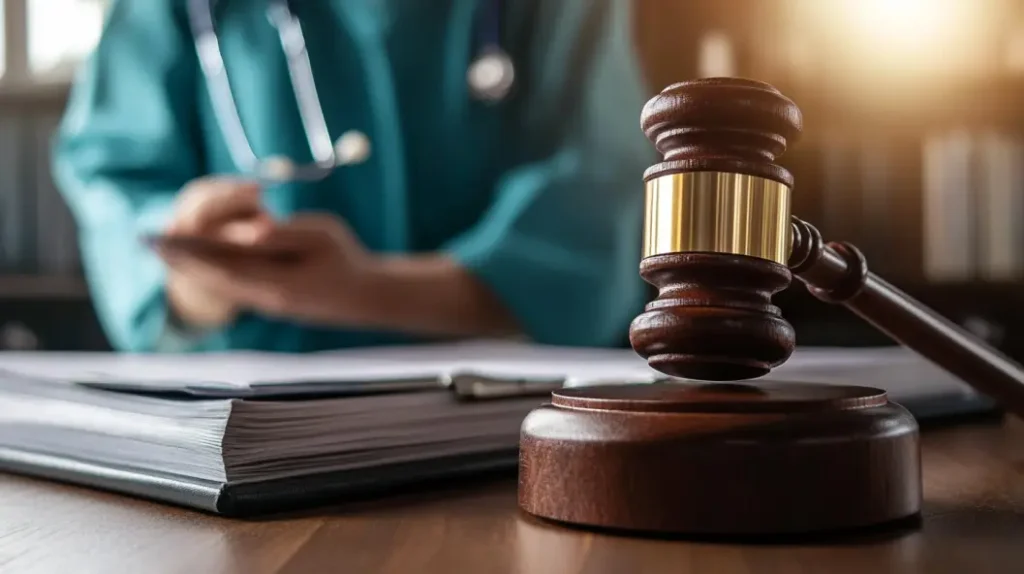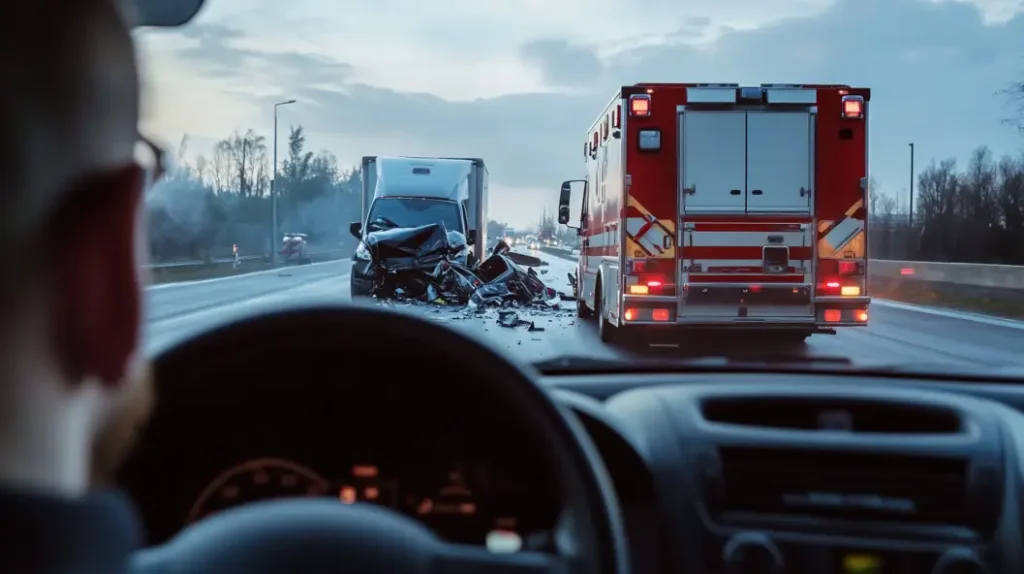Truck accidents in Sarasota are among the most serious types of vehicle collisions, often leading to devastating injuries, complex legal battles, and financial hardships for those involved. As the Sarasota area has grown in population substantially in just a few years major roads like US 41, US 301 and Interstate-75 are seeing more truck traffic than ever. Given the massive size and weight of commercial trucks, accidents involving these vehicles frequently have severe consequences, impacting not only the individuals directly involved but also their families and livelihoods. In the chaotic aftermath of a truck accident, it can be overwhelming to know where to start. However, documenting evidence at the accident scene is one of the most powerful steps a victim can take to protect their rights and strengthen any future legal case.
Evidence gathered immediately after an accident often becomes the foundation for proving fault, securing compensation, and building a successful claim. Without clear documentation, it can be challenging for attorneys to demonstrate the full impact of the accident or to counteract the often extensive legal resources of commercial trucking companies and their insurers. From photos and videos of the scene to witness information and police reports, each piece of evidence plays a vital role in piecing together the truth of what happened.
In Sarasota, unique road designs, high traffic volume, and the mix of local and tourist drivers create specific conditions that can complicate truck accident cases. Routes frequently used by commercial trucks, such as I-75 and the Tamiami Trail, can be hotspots for accidents, and documenting these scenes accurately can make or break a case. Every detail—from road conditions to traffic signals and visibility—can impact the outcome of a legal claim. That’s why understanding the steps to effectively gather evidence and having a skilled auto accident attorney by your side can make all the difference in handling a complex truck accident in Sarasota.
Why Documentation Matters In A Truck Accident Case

When it comes to truck accidents in Sarasota, properly documented evidence is a cornerstone in establishing fault and securing the compensation victims need to recover. Trucking companies and their insurers are often well-prepared with legal resources, and they don’t hesitate to use them to protect their interests. As a result, anyone involved in a truck accident is up against a highly organized system designed to minimize or deny claims. This makes having well-documented, detailed evidence absolutely critical in proving fault and building a case that can withstand scrutiny in negotiations or, if necessary, in court.
For Sarasota auto accident attorneys, reliable evidence is essential to negotiating fair settlements and, when needed, winning cases in court. Truck accidents can quickly become complicated, especially when dealing with commercial trucking companies that may employ aggressive defense tactics. In these situations, attorneys rely on a wide range of evidence—photos and videos of the accident scene, witness statements, the police report, and, when applicable, data from the truck’s electronic logging device (ELD). Each piece of this puzzle provides vital insight, giving attorneys the leverage they need to negotiate with insurers or present a compelling case in court.
Solid evidence also plays a key role in establishing the full extent of the damages suffered. Sarasota truck accident victims often face a long and expensive recovery process, with medical bills, rehabilitation costs, and lost wages piling up quickly. Physical and emotional pain and suffering add further to the impact on their lives. Without documented evidence to demonstrate the severity of these damages, it’s much harder to secure the full compensation required for recovery. With thorough evidence, however, attorneys can strengthen the case for fair compensation that covers not only immediate medical expenses but also the financial impact of lost wages and the ongoing toll of pain and suffering.
In truck accident cases, solid documentation is more than just a tool—it’s a form of protection. With the right evidence, Sarasota accident victims have a greater chance of proving fault and holding powerful trucking companies accountable. This gives victims the peace of mind they deserve, knowing that their case has a solid foundation and a team of attorneys working tirelessly on their behalf.
After a truck accident in Sarasota, certain documents can be game-changers when building a solid legal case. Each document provides a unique perspective on the accident’s impact, from establishing fault to outlining the full scope of damages. Gathering these documents promptly and thoroughly is one of the best ways to support your claim for compensation and help your attorney build a case that stands strong against the trucking company and their insurers. Here’s a look at the essential documents that can make a significant difference in Sarasota truck accident cases.
Police Report:
The police report is often one of the first pieces of evidence attorneys review after a truck accident. This official document, prepared by the responding officer, captures essential details about the accident, including the initial assessment of fault. Officers may note factors such as traffic violations, witness statements, or any observable signs of negligence, like distracted or impaired driving. Obtaining a copy of the Sarasota police report is relatively straightforward; you can request it from the Sarasota Police Department or through Florida’s Crash Portal. However, timing is key—it’s best to get a copy as soon as it becomes available to ensure your attorney has the facts early on. This report not only provides an authoritative account but also offers a starting point for deeper investigations, helping your attorney identify other critical pieces of evidence.
Medical Records:

Medical records serve as the foundation for proving the injuries you sustained in the accident, linking them directly to the incident. These records go beyond the immediate post-accident treatment and may include ongoing care, rehabilitation, or physical therapy, highlighting the severity and long-term impact of your injuries. Accurate medical documentation establishes a timeline, showing how injuries were diagnosed and treated and whether they resulted in permanent or prolonged limitations. Your medical records should cover emergency room visits, physician consultations, and any specialist care, as each component adds weight to the extent of the physical and financial burden the accident placed on you. This documentation is critical not just for obtaining compensation for medical bills but also for substantiating claims for pain and suffering.
Repair and Damage Estimates:
The damage to your vehicle, or any other property, is another significant factor in determining compensation. Repair and damage estimates provide a tangible dollar figure representing the accident’s immediate financial impact. After the accident, it’s crucial to seek estimates from a reputable repair shop to assess the cost of repairs—or, if the vehicle is a total loss, the replacement cost. Photos of the vehicle’s condition post-accident can also complement these estimates by visually capturing the extent of the damage. Not only does this help in substantiating property damage claims, but it also provides your attorney with a clearer picture of the accident’s force and severity, which may further support evidence of fault.
Employment Records:
Missed workdays due to accident-related injuries can add up quickly, leading to lost income that may be challenging to recover without proper documentation. Employment records detailing missed days, reduced work capacity, or even job termination as a result of the accident are essential for proving lost wages. These records can include pay stubs, letters from your employer, or medical recommendations that outline restrictions on physical activities. In many truck accident cases, victims face extended recovery periods, and having proof of the impact on your employment is critical in securing compensation not only for lost wages but also for reduced earning capacity if injuries prevent you from returning to your previous job.
Together, these key documents create a comprehensive picture of the accident’s impact on your life. By gathering a Sarasota police report, detailed medical records, repair and damage estimates, and employment documentation, you’re providing your attorney with the tools to negotiate from a position of strength. This attention to documentation can be the difference in achieving the compensation you need to recover and rebuild after a Sarasota truck accident.
In complex Sarasota truck accident cases, the role of evidence is absolutely pivotal, and experienced accident lawyers at Goldman, Babboni, Fernandez, Murphy & Walsh know how to turn a well-documented case into a strong, compelling argument for their clients. Every piece of evidence gathered—from photos and witness statements to more technical data—serves a purpose in illustrating the accident’s cause and establishing liability. Attorneys examine the available evidence with a keen eye, piecing together details to construct documentation that shows exactly how the accident happened, who was responsible, and how the resulting injuries have affected their clients’ lives.
One of the first steps an attorney takes is analyzing physical evidence, like vehicle damage, road conditions, and skid marks, which can often reveal crucial information about the accident’s impact. For example, the angle and extent of vehicle damage can help determine the point of collision and the speed at which the vehicles were traveling. This physical evidence, while essential, is often just the beginning—particularly in cases involving commercial trucks, where liability can be more complicated to prove due to multiple parties involved, such as the truck driver, the trucking company, and potentially third-party maintenance providers. Attorneys must establish a clear connection between the at-fault party’s actions and the accident, which requires a thorough and multi-layered approach to evidence.
In addition to physical evidence, digital evidence has become increasingly important in proving fault in truck accident cases. Many commercial trucks are equipped with dashcams, which can offer a direct, real-time view of the moments leading up to the accident. Dashcam footage provides critical insights that might otherwise be missed, such as sudden lane changes, braking patterns, or driver behavior just before impact. Attorneys use this footage to corroborate witness statements or police reports, strengthening the case for liability. Traffic camera records, if available, offer another angle, sometimes capturing the broader scene, including other vehicles on the road or road conditions that may have influenced the crash.
A unique piece of digital evidence in truck accident cases is data from the truck’s Electronic Logging Device (ELD). ELDs are mandatory in commercial trucks to record driving hours, helping to prevent driver fatigue by limiting hours on the road. However, this data can also be a treasure trove of information in an accident investigation. ELD data can reveal whether the driver was in compliance with hours-of-service regulations, whether they were speeding, and whether they took necessary breaks. Non-compliance with these rules is often a sign of negligence on the part of the driver or the trucking company, especially if they pressured the driver to work beyond safe limits. By analyzing ELD data, attorneys can identify if fatigue or excessive hours played a role in the accident, which could directly impact liability.
Beyond identifying fault, digital evidence like dashcam footage and ELD data allows attorneys to anticipate and counteract potential defenses from the trucking company and their insurers. Trucking companies have extensive legal teams dedicated to minimizing liability, and they often rely on well-practiced arguments to deflect blame. For instance, they may argue that road conditions, other drivers, or unforeseeable circumstances caused the accident, rather than any fault on their part. However, with solid digital evidence, a local and experienced truck accident attorney can directly challenge these claims, showing that the truck driver’s behavior, fatigue, or negligence was the root cause of the crash.

By leveraging every piece of evidence—from physical debris to advanced digital data—Sarasota auto accident attorneys can build a well-rounded case that not only establishes fault but also anticipates and neutralizes potential defenses. This comprehensive approach gives victims the best chance at securing the compensation they need to recover and rebuild after a traumatic truck accident, holding responsible parties accountable and ensuring justice for their clients.
After a truck accident, the immediate moments are often chaotic and overwhelming, with so much happening at once that it’s easy to overlook critical steps in documenting evidence. However, even small mistakes in how evidence is gathered at the scene can have significant consequences when it comes time to negotiate for fair compensation. Failing to document effectively can make it more challenging for attorneys to establish fault, demonstrate the full impact of the accident, and secure the compensation you deserve. By understanding common documentation pitfalls and how to avoid them, you can strengthen your case and make it easier for your attorney to build a solid argument on your behalf.
One of the most common mistakes people make after an accident is failing to collect witness information. Witnesses can be incredibly valuable in a truck accident case, providing an objective perspective on how the accident unfolded and potentially corroborating your account of events. However, witnesses often move on quickly after the accident, and their statements can become difficult, if not impossible, to gather later on. Taking a few moments to ask for names and contact details ensures that your attorney can follow up with witnesses who may have seen critical details you missed in the chaos. Without witness testimonies, your case might lack the extra layer of credibility needed to support your version of events.
Another frequent pitfall is neglecting to capture detailed photos and videos from various angles of the accident scene. Many people take a few quick photos, but they may miss angles that provide essential context, such as the position of both vehicles, any visible skid marks, and the surrounding area. Detailed photos should include not only close-ups of vehicle damage but also wider shots that capture road conditions, traffic signals, and any potential obstructions or hazards in the area. Missing these shots can mean losing vital evidence that might help prove fault or demonstrate the severity of the crash. Attorneys at Goldman, Babboni, Fernandez, Murphy & Walsh rely on these visuals to reconstruct the accident and counter any claims from the trucking company or their insurer that the accident was less serious than it was.
Waiting too long to document injuries is another mistake that can weaken a case. While the adrenaline from the accident might make some injuries feel less intense at first, these injuries can worsen in the hours or days following the collision. Photographing any visible injuries, such as bruises or cuts, right after the accident provides a timestamped record of the harm you sustained, which can be important in showing that the injuries were directly caused by the crash. Similarly, it’s essential to seek medical attention promptly and follow up with a detailed medical report, which serves as further documentation of your injuries. Delays in documenting or treating injuries can give insurance companies room to argue that your injuries are unrelated to the accident or not as severe as claimed.
Another mistake people often make is underestimating the value of everyday technology in capturing evidence. Most smartphones have features that can provide location, date, and time stamps on photos and videos. This information is often crucial in verifying when and where the evidence was collected, adding credibility to your documentation. However, many accident victims may forget to use these features, potentially weakening the evidence’s reliability if the insurance company or opposing legal team questions its accuracy.

Finally, it’s easy to get caught up in the details and forget to stay organized. If you end up with scattered photos, videos, and contact information, it can complicate things for both you and your attorney. Having a system—whether it’s creating a dedicated folder on your phone or keeping a physical notebook—can ensure that all evidence is easily accessible. An organized approach can save time and prevent critical details from getting lost.
Each of these common mistakes can add unnecessary complications to your truck accident case, potentially making it more difficult for your attorney to present a compelling argument for compensation. By avoiding these pitfalls and being mindful of the details, you not only strengthen your case but also make it easier for your attorney to focus on advocating for you effectively. Ensuring thorough documentation from the start can make a significant difference in the outcome of your Sarasota truck accident claim, helping your legal team build a strong case that holds responsible parties accountable and supports your right to fair compensation.
When it comes to gathering evidence after a truck accident, a little organization and proactive effort can go a long way in helping your Sarasota truck accident attorney build a strong case. Many people are understandably shaken after an accident and may not know where to start with evidence collection, but following a few practical tips can ensure that you’re documenting effectively and preserving the details that matter most. Here are some key strategies that Sarasota truck accident attorneys recommend for documenting evidence after an accident to strengthen your case and maximize your chances of fair compensation.
Stay Organized:
Keeping all of your evidence in a single, easily accessible location can make a big difference in staying on top of your case. Consider creating a dedicated folder—whether physical or digital—for all accident-related documents. This might include your photos, witness contact information, the police report, and any medical records related to your injuries. If you’re storing items digitally, consider creating a special folder on your phone or computer where everything is neatly labeled and dated. Staying organized prevents essential evidence from getting lost and allows your attorney to review everything quickly without delays. It also simplifies the process for you, making it easier to share information and track the progress of your claim without sifting through emails, paper stacks, or scattered notes.
Back-Up Digital Evidence:
Digital evidence is incredibly valuable in a truck accident case—photos of the scene, videos, and witness recordings all play a vital role in building a clear picture of the accident. However, the last thing you want is to accidentally lose this data due to phone damage, accidental deletion, or other technical mishaps. It’s a good idea to back up your digital evidence in multiple locations. For instance, you could save copies to a cloud storage service (like Google Drive or Dropbox) and also transfer them to your computer. This way, if one source fails, you still have a secure copy stored elsewhere. Taking these extra precautions ensures that valuable evidence remains intact and accessible, so your Sarasota truck accident attorney at Goldman, Babboni, Fernandez, Murphy & Walsh has everything they need to advocate for you.
Seek Legal Guidance Quickly:

After an accident, contacting an attorney as soon as possible is one of the smartest steps you can take. When you bring a Sarasota truck accident attorney on board early, they can provide guidance on what specific evidence will best support your case and even take steps to help preserve certain types of evidence. For example, they may issue a “preservation of evidence” letter to the trucking company, requiring them to keep important data like the truck’s electronic logging device (ELD) records or maintenance logs. These documents can be crucial in proving liability, especially if there’s evidence of driver fatigue, excessive hours, or mechanical issues. An attorney can also help secure traffic camera footage or other time-sensitive records that might be difficult to obtain later on. By seeking legal help promptly, you give yourself the best chance of preserving critical evidence and avoiding any gaps in your case.
Use Technology:
These days, smartphones are equipped with a variety of features and apps that make documenting evidence easier than ever. For example, your phone camera can capture high-quality images and videos, and location services can tag these files with the exact time and place they were taken. You can also use note-taking apps (such as Evernote or Google Keep) to jot down important details like the sequence of events, descriptions of injuries, and statements from witnesses. There are even specialized accident documentation apps, like “CamOnRoad” or “SOSmart,” which can assist with automatically recording GPS data and even provide emergency contact features. Using technology not only makes documentation faster but also ensures that you’re gathering comprehensive evidence from multiple angles. Your Sarasota truck accident attorney can then use this well-organized digital data to help piece together a stronger, clearer case.
By staying organized, backing up evidence, seeking legal guidance promptly, and using the technology at your disposal, you can make sure that the evidence from your truck accident is solid, thorough, and ready to support your claim. Truck accident cases often involve intense scrutiny from insurance companies and the trucking industry’s legal teams, so these simple steps can make a big difference in strengthening your case and helping your attorney secure the outcome you deserve. Taking these proactive measures can give you peace of mind and put you on the right path to a successful resolution.
When you’ve gathered all the necessary evidence after a truck accident in Sarasota, the next step is ensuring that this information is organized and ready to be presented to your attorney here at Goldman, Babboni, Fernandez, Murphy & Walsh. A well-organized collection of evidence can make a significant difference in how efficiently your case is prepared and how compellingly it is presented to insurance adjusters, opposing attorneys, or even a judge. By taking a few extra steps to prepare your evidence, you help your Sarasota truck accident attorney gain a clear understanding of the accident’s details, making it easier for them to focus on the critical aspects of building a strong case.
Organize Evidence in a Dedicated Folder or File:
Start by gathering all your documents, photos, videos, witness information, medical records, and repair estimates in one place, either a physical folder or a digital one on your computer or cloud storage. Keeping everything in one spot minimizes the chances of losing any key piece of evidence, especially as the case progresses and more documentation may be added. If you’re opting for a digital folder, label each file clearly so that it’s immediately obvious what each item represents. For instance, label files as “accident scene photo – front of truck,” “police report,” or “medical report – Dr. Smith, Initial Visit.” This makes it easier for your attorney to quickly navigate through the documents and spot any gaps that may need further investigation.
Maintain a Chronological Timeline:
A chronological timeline can help paint a clear picture of the sequence of events before, during, and after the accident. This timeline doesn’t have to be complex—just a simple list that includes dates and key details. For example, you might include the time and date of the accident, when the police report was filed, when you sought medical attention, and any follow-up treatments. If you received any communications from insurance companies or the trucking company, note these dates as well. This organized timeline allows your attorney to see the progression of the case and highlights key events or time-sensitive actions that might be relevant for the claim.
Label Photos and Videos Thoroughly:
Photos and videos are among the most persuasive pieces of evidence, but they’re only helpful if their context is clear. For each photo or video, add a brief description, either by labeling the file or keeping a separate document where each image is described. Notations like “skid marks near intersection,” “bruising on arm, day of accident,” or “close-up of truck damage” give your attorney an immediate sense of what each piece of visual evidence represents. Additionally, if your phone or camera automatically timestamps photos, make sure this feature is enabled. Timestamps can be essential in verifying the sequence of events and proving that the photos were taken immediately after the accident, further supporting your account.
Provide Context for Each Piece of Evidence:
Context is key in making your evidence useful and compelling. For example, if you have photos of the accident scene, write a short description of what’s visible in the image and why it’s relevant. Similarly, if you’ve recorded witness statements or conversations, include a note about who the person is and their connection to the accident, like “bystander who saw the truck run the red light.” This helps your attorney quickly grasp the significance of each piece of evidence and understand how it supports your claim. Providing context not only streamlines their review process but also allows them to strategize how best to use each item to strengthen your case.
Share a Summary of Any Verbal or Written Interactions You’ve Had:
If you’ve had any conversations with insurance representatives, the trucking company, or witnesses, jot down the details and any relevant dates. Even informal conversations can be important to your case, especially if they involved statements that may imply responsibility or provide additional insights. Written communication, like emails or letters, should be added to your folder, as they create a record that your attorney can reference during negotiations or court proceedings.
By following these steps, you’re assisting your attorney at Goldman, Babboni, Fernandez, Murphy & Walsh with clear, structured overview of the evidence in your case, making it easier for them to start building your argument immediately. A well-organized presentation of evidence can streamline the preparation process, allowing your attorney to dive deeper into the legal strategy rather than sifting through disorganized files. It shows that you’re taking the case seriously and are prepared to support your claim with reliable, documented proof.
Properly documenting and presenting evidence is one of the most impactful steps you can take after a truck accident in Sarasota. This evidence becomes the foundation of your case, providing the essential details needed to prove fault, illustrate the full extent of your injuries, and support your claim for fair compensation. By staying organized, using technology to document the scene, and gathering every necessary document promptly, you set yourself up for success. These steps ensure that your Sarasota auto accident attorney at Goldman, Babboni, Fernandez, Murphy & Walsh has everything they need to build a strong, persuasive case on your behalf. If you or a loved one have been involved in a truck accident, contact a Sarasota auto accident attorney promptly to protect your rights and secure the best possible outcome. Effective documentation not only strengthens your case but also gives you peace of mind as you begin the process of recovery and justice.
More Information About Trucking Accident Cases & Documentation
Florida Department of Highway Safety and Motor Vehicles (FLHSMV)
- Source for Police Reports: Provides guidance on obtaining traffic crash reports in Florida, including online access through the Florida Crash Portal.
- Website: FLHSMV Traffic Crash Reports
Federal Motor Carrier Safety Administration (FMCSA)
- Source on ELD Data: Discusses electronic logging device (ELD) requirements, hours-of-service regulations, and how ELD data can be critical in determining driver compliance in truck accidents.
- Website: FMCSA ELD Information
American Bar Association (ABA)
- Source on Evidence Documentation and Legal Cases: Offers guidelines on the importance of preserving evidence and effective documentation practices for personal injury and auto accident cases.
- Website: ABA on Evidence in Legal Cases
National Highway Traffic Safety Administration (NHTSA)
- Source on Accident Documentation: NHTSA provides general guidance on collecting evidence after an accident and explains the importance of documenting injuries and property damage for legal cases.
- Website: NHTSA Guidelines on Accident Documentation
Insurance Information Institute (III)
- Source on Accident Scene Evidence: Offers consumer-oriented guidance on what to do after an accident, including the types of evidence to collect and why they matter for insurance claims and legal processes.
- Website: III Accident Scene Guidelines
National Safety Council (NSC)
- Source on Witness Statements and Accident Scene Documentation: The NSC discusses best practices for gathering witness information and photographing the accident scene to support claims.
- Website: NSC Accident Documentation Tips
The post Tips On Effective Evidence Documentation for Sarasota Truck Accidents appeared first on Justice Pays.




